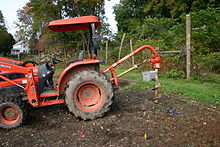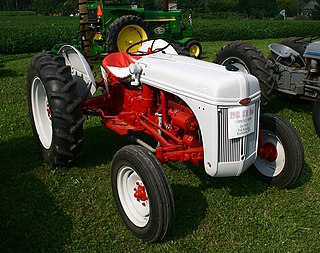
A tractor is an engineering vehicle specifically designed to deliver a high tractive effort at slow speeds, for the purposes of hauling a trailer or machinery such as that used in agriculture, mining or construction. Most commonly, the term is used to describe a farm vehicle that provides the power and traction to mechanize agricultural tasks, especially tillage, and now many more. Agricultural implements may be towed behind or mounted on the tractor, and the tractor may also provide a source of power if the implement is mechanised.

A drill is a tool used for making round holes or driving fasteners. It is fitted with a bit, either a drill or driverchuck. Hand-operated types are dramatically decreasing in popularity and cordless battery-powered ones proliferating due to increased efficiency and ease of use.
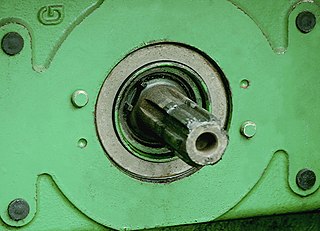
A power take-off or power takeoff (PTO) is one of several methods for taking power from a power source, such as a running engine, and transmitting it to an application such as an attached implement or separate machine.

Drill bits are cutting tools used in a drill to remove material to create holes, almost always of circular cross-section. Drill bits come in many sizes and shapes and can create different kinds of holes in many different materials. In order to create holes drill bits are usually attached to a drill, which powers them to cut through the workpiece, typically by rotation. The drill will grasp the upper end of a bit called the shank in the chuck.
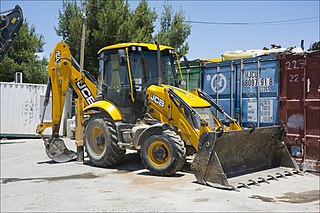
A backhoe loader, also called a loader backhoe, loader excavator, digger in layman's terms, or colloquially shortened to backhoe within the industry, is a heavy equipment vehicle that consists of a tractor-like unit fitted with a loader-style shovel/bucket on the front and a backhoe on the back. Due to its (relatively) small size and versatility, backhoe loaders are very common in urban engineering and small construction projects as well as developing countries. This type of machine is similar to and derived from what is now known as a TLB (Tractor-Loader-Backhoe), which is to say, an agricultural tractor fitted with a front loader and rear backhoe attachment.

A transmission is a mechanical device which uses gears to change the speed or direction of rotation in a machine. Many transmissions have multiple gear ratios, but there are also transmissions that use a single fixed gear ratio.
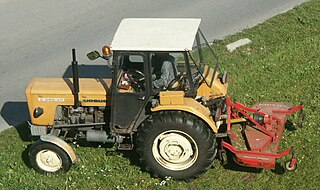
The three-point hitch is a widely used type of hitch for attaching ploughs and other implements to an agricultural or industrial tractor. The three points resemble either a triangle, or the letter A. Three-point attachment is the simplest and the only statically determinate way of joining two bodies in engineering.

The Ferguson-Brown Company was a British agricultural machinery manufacturing company formed by Harry Ferguson in partnership with David Brown.

A cultivator is a piece of agricultural equipment used for secondary tillage. One sense of the name refers to frames with teeth that pierce the soil as they are dragged through it linearly. It also refers to machines that use the rotary motion of disks or teeth to accomplish a similar result. The rotary tiller is a principal example.

The Ford N-series tractors were a line of farm tractors produced by Ford between 1939 and 1952, spanning the 9N, 2N, and 8N models.

A bush hog or "brush hog" is a type of rotary mower. Typically these mowers attach to the back of a farm tractor using the three-point hitch and are driven via the power take-off (PTO). It has blades that are not rigidly attached to the drive like a lawnmower blade, but are on hinges so if the blade hits a rock or stump, it bounces backward and inward, and then centrifugal force makes it go outwards again.

A broadcast seeder, alternately called a broadcaster, broadcast spreader or centrifugal fertilizer spreader (Europe) or "spinner" (UK), is a farm implement commonly used for spreading seed where no row planting is required (mostly for lawns and meadows: grass seeds or wildflower mixes), lime, fertilizer, sand, ice melt, etc., and is an alternative to drop spreaders/seeders. Apart from spinners there is also a type of broadcast spreader called "wagtail spreader" (the name describing the movement of its distributing part), used with tractors.

A flail mower is a type of powered garden/agricultural equipment which is used to deal with heavier grass/scrub which a normal lawn mower could not cope with. Some smaller models are self-powered, but many are PTO driven implements, which can attach to the three-point hitches found on the rear of most tractors. This type of mower is best used to provide a rough cut to long grass and even brambles in locations such as roadsides, where contact with loose debris may be possible.

A mixer-wagon, or diet feeder, is a specialist agricultural machine used for accurately weighing, mixing and distributing total mixed ration (TMR) for ruminant farm animals, in particular cattle and most commonly, dairy cattle.
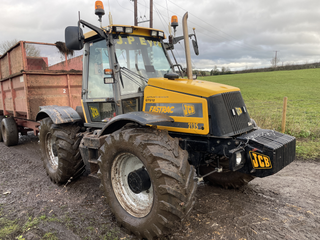
The JCB Fastrac is a high-speed agricultural tractor series manufactured by JCB Landpower, part of the JCB group.
A post hole clam-shell digger, also called post hole pincer or simply post hole digger, is a tool consisting of two articulated shovel-like blades, forming an incomplete hollow cylinder about a foot long and a few inches wide, with two long handles that can put the blades in an "open" (parallel) position or a "closed" (convergent) position.

ZT 300 is a series of 20 kN agricultural tractors, produced from 1 September 1967 to 1984 by the VEB Traktorenwerk Schönebeck. It succeeded the RS14 Famulus series, and unlike the Famulus, the ZT 300 series was sold under the brand name Fortschritt. ZT 300 refers both to the initial ZT 300 model, and the ZT 300 series. In total, 72,382 units of the ZT 300 series were made. The model with the highest production figure was the ZT 303, which was introduced in 1972. It features an automatic all-wheel-drive system; in the early 1980s, it cost 81.000 Mark. Starting in 1983, the ZT 300 series was succeeded by the ZT 320.

The Unimog 406 is a vehicle of the Unimog-series by Mercedes-Benz. A total of 37,069 units were manufactured by the Daimler-Benz AG in the Unimog plant in Gaggenau from 1963 to 1989. The 406 was the first medium duty Unimog, having a larger wheelbase of 2380 mm and more than twice the engine power of the Unimog 401. Unlike the initial Unimog, the 406 does not have a car engine but a heavy duty truck engine instead. Several following Unimog versions were based on the 406. There were eleven different types made of the Unimog 406, which were available in four models with a closed two-door or four-door cab, as Cabrio and as an OEM part. During its long production period, the 406 received several technical refinements. In 1964, the precombustion chamber diesel engine OM 312 was replaced with the direct injected OM 352. Disc brakes followed in 1973. For many enthusiasts, the Unimog 406 represents the classical Unimog, having agricultural and silvicultural applications. It was successful and the best embodiment of the word Universal-Motor-Gerät considering all prior Unimogs.
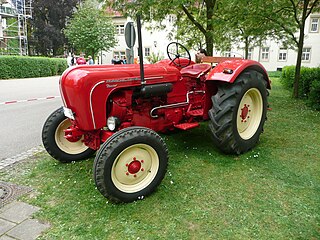
The Porsche-Diesel 419 is an agricultural tractor made by Porsche-Diesel Motorenbau, and part of Porsche's Master series. It was the biggest and most powerful series-production tractor ever sold under the Porsche brand. In total, 1175 units were produced from 1960 until 1963. The 419 was preceded by the 418, and had no successor, since Porsche-Diesel Motorenbau stopped producing tractors in 1963. That same year, the catalogue price for a Porsche-Diesel 419 was DM 15,290.

An earth auger, earth drill, or post-hole auger is a drilling tool or machine used for making holes in the ground. It typically consists of a rotating vertical metal rod or pipe with one or more blades attached at the lower end, that cut or scrape the soil.
